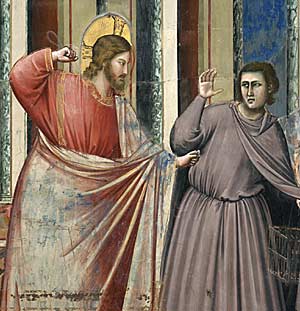
 |
| Detail showing Christ casting the money-changers out of the temple |
The stories of the childhood and life of Christ take up the entire central
register on both walls. The scenes painted on either side of the chancel
arch perform a crucial transitional function. The Visitation (on the right,
below the Virgin of the Annunciation) directly connects the beginning
of the Christ cycle with the preceding cycle, dedicated to the Virgin,
while the Hiring of Judas (on the left) marks the end of Christ's public
existence in a dramatic fashion, and links this cycle with that of the
Passion, which begins with the Last Supper.
In this way a perfect connection is established between the three registers:
above, stories concerning Jesus' grandparents and parents; in the middle,
his earthly life; below, the Passion and the events following his death,
up to Pentecost.
For the frescoes in the middle register, Giotto could draw on many visual
models, among them the marble pulpits by Nicola and Giovanni Pisano at
Siena and Pisa, the mosaic decorations in the Florence Baptistery, and
frescoes and mosaics in Rome. In comparison with all these precedents,
Giotto's cycle is more detailed and includes a number of important iconographic
innovations. The scenes with the strongest compositional resemblance to
reliefs are the first two, the Nativity and the Adoration of the Magi.
To appreciate fully what the scenes of the life of Christ originally looked
like, we must remember that all the areas painted 'a secco' rather than
in the more resistant 'a fresco' technique have disintegrated. The cloaks
of some of
the characters - such as that of the Virgin in the first four scenes -
were originally painted with the azurite: in its place a greyish shade
is left, impoverishing the chromatic effect of the whole.
Sources
The obvious literary source for the life of Christ is the Gospels, especially
that of Matthew. There are, however, a few references to the Protevangelium
of James (or rather to its transcription in the Golden Legend), such as
the presence of a midwife in the Nativity scene.
Iconography
Giotto includes many allusions to works of art and architecture in this
series of scenes. Indeed, their sheer quantity has given rise to the suggestion
that he may have had access to a sketchbook containing schematic drawings
of famous monuments. The baldacchino in the Cosmati style first seen in
the cycle of Joachim and Anna returns in the Presentation of Jesus in
the Temple; the background of the Massacre of the Innocents contains the
apse of a buttressed Gothic church, possibly inspired by San Francesco
at Bologna; and there are statues of horses and lions, surely of Venetian
inspiration, over the arcade of the church in which the Expulsion of the
Merchants takes place.
The Adoration of the Magi is of great iconographic interest because it
includes several innovations and what is probably an image of Halley's
Comet.